Starting
Positions of the ignition
1. LOCK, locks the steering wheel, gearshift lever (automatic transaxle only) and allows key removal. On vehicles with a manual transaxle push the key in while turning to lock.
2. ACCESSORY, allows the electrical accessories such as the radio to operate while the engine is not running.
3. ON, all electrical circuits operational. Warning lights illuminated. Key position when driving.
4. START, cranks the engine. Release the key as soon as the engine starts.
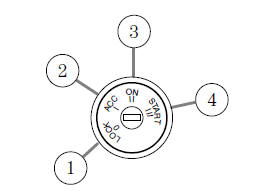
Preparing to start your vehicle
Engine starting is controlled by the powertrain control system. This system meets all Canadian Interference-Causing Equipment standard requirements regulating the impulse electrical field strength of radio noise.
When starting a fuel-injected engine, avoid pressing the accelerator before or during starting. Only use the accelerator when you have difficulty starting the engine. For more information on starting the vehicle, refer to Starting the engine in this chapter.
Extended idling at high engine speeds can produce very high temperatures in the engine and exhaust system, creating the risk of fire or other damage.
Do not park, idle, or drive your vehicle in dry grass or other dry ground cover. The emission system heats up the engine compartment and exhaust system, which can start a fire.
Do not start your vehicle in a closed garage or in other enclosed areas. Exhaust fumes can be toxic. Always open the garage door before you start the engine. See Guarding against exhaust fumes in this chapter for more instructions.
If you smell exhaust fumes inside your vehicle, have your dealer inspect your vehicle immediately. Do not drive if you smell exhaust fumes.
Make sure the corresponding lights illuminate or illuminate briefly. If a light fails to illuminate, have the vehicle serviced.
- If the driver's safety belt is fastened, the
 light may not illuminate.
light may not illuminate.
Important safety precautions
When the engine starts, the idle RPM runs faster to warm the engine. If the engine idle speed does not slow down automatically, have the vehicle checked.
Before starting the vehicle:
1. Make sure all occupants buckle their safety belts. For more information on safety belts and their proper usage, refer to the Seating and safety restraints chapter.
2. Make sure the headlamps and electrical accessories are off.
If starting a vehicle with an automatic transaxle:
- Make sure the parking brake is set.
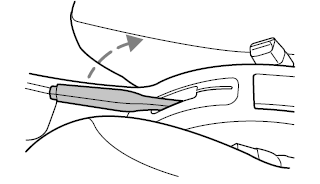
- Make sure the gearshift is in P (Park).
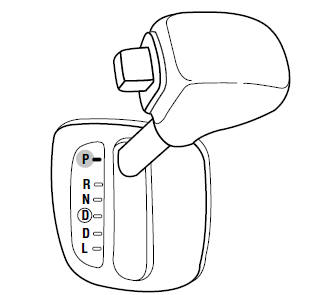
If starting a vehicle with a manual transaxle:
1. Make sure the parking brake is set.
2. Push the clutch pedal to the floor.
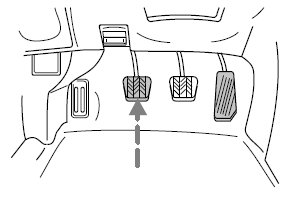
- Turn the key to 3 (ON) without turning the key to 4 (START).
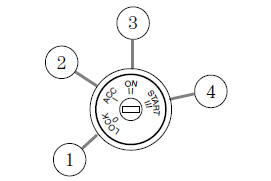
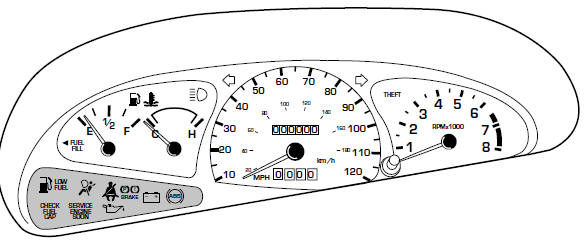
Make sure the corresponding lights illuminate or illuminate briefly. If a light fails to illuminate, have the vehicle serviced.
- If the driver's safety belt is fastened, the
 light may not illuminate.
light may not illuminate.
Starting the engine
1. Turn the key to 3 (ON) without turning the key to 4 (START). If there is difficulty in turning the key, rotate the steering wheel until the key turns freely. This condition may occur when:
- the front wheels are turned
- a front wheel is against the curb
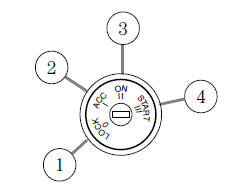
Turn the key to 4 (START), then release the key as soon as the engine starts. Excessive cranking could damage the starter.
Note: If the engine does not start within five seconds on the first try, turn the key to 1 (LOCK), wait 10 seconds and try again.
Using the engine block heater (if equipped)
An engine block heater warms the engine coolant which aids in starting and heater/defroster performance. Use of an engine block heater is strongly recommended if you live in a region where temperatures reach -23Вє C (-10Вє F) or below. For best results, plug the heater in at least three hours before starting the vehicle. The heater can be plugged in the night before starting the vehicle.
To prevent electrical shock, do not use your heater with ungrounded electrical systems or two-pronged (cheater) adapters.
Guarding against exhaust fumes
Carbon monoxide is present in exhaust fumes. Take precautions to avoid its dangerous effects.
If you smell exhaust fumes inside your vehicle, have your dealer inspect your vehicle immediately. Do not drive if you smell exhaust fumes.
Important ventilating information
If the engine is idling while the vehicle is stopped for a long period of time, open the windows at least 2.5 cm (one inch) or adjust the heating or air conditioning to bring in fresh air.
See also:
Body electrical system
General information and precautions
General information
The electrical system is of the 12 volt.
negative earth type. Electricity is generated by
an alternator, belt-driven from the crankshaft
pu ...
Carburettor overhaul - general information
Faults with the carburettor are usually
associated with dirt entering the float
chamber and blocking the jets, causing a
weak mixture or power failure within a certain
engine speed range. If this ...
Crankshaft front oil seal - renewal
1.8 litre (R2A type)
1 Remove the timing belt and the crankshaft
sprocket and thrustwasher.
2 Withdraw the oil seal using an oil seal
removal tool or by drilling the oil seal outer
face and using ...
